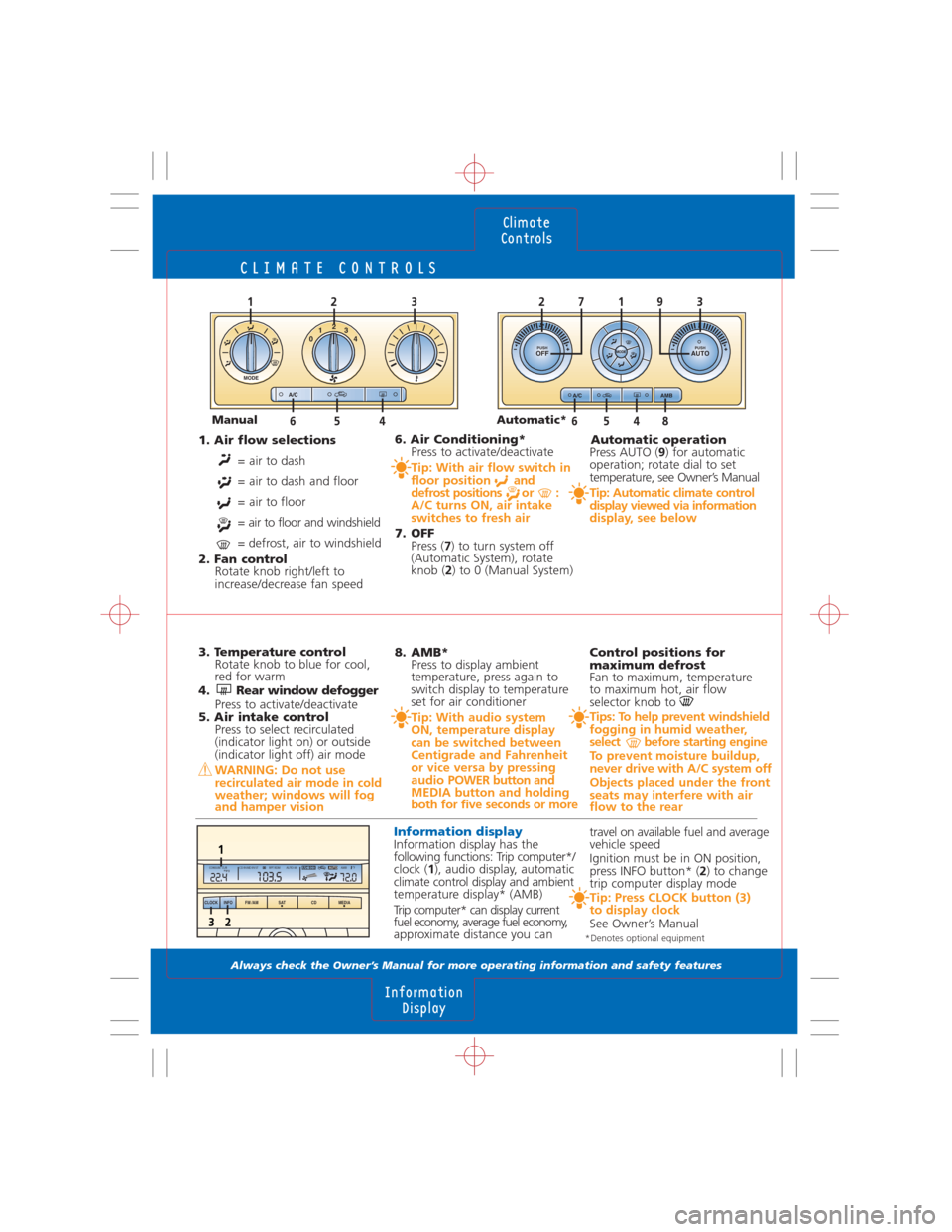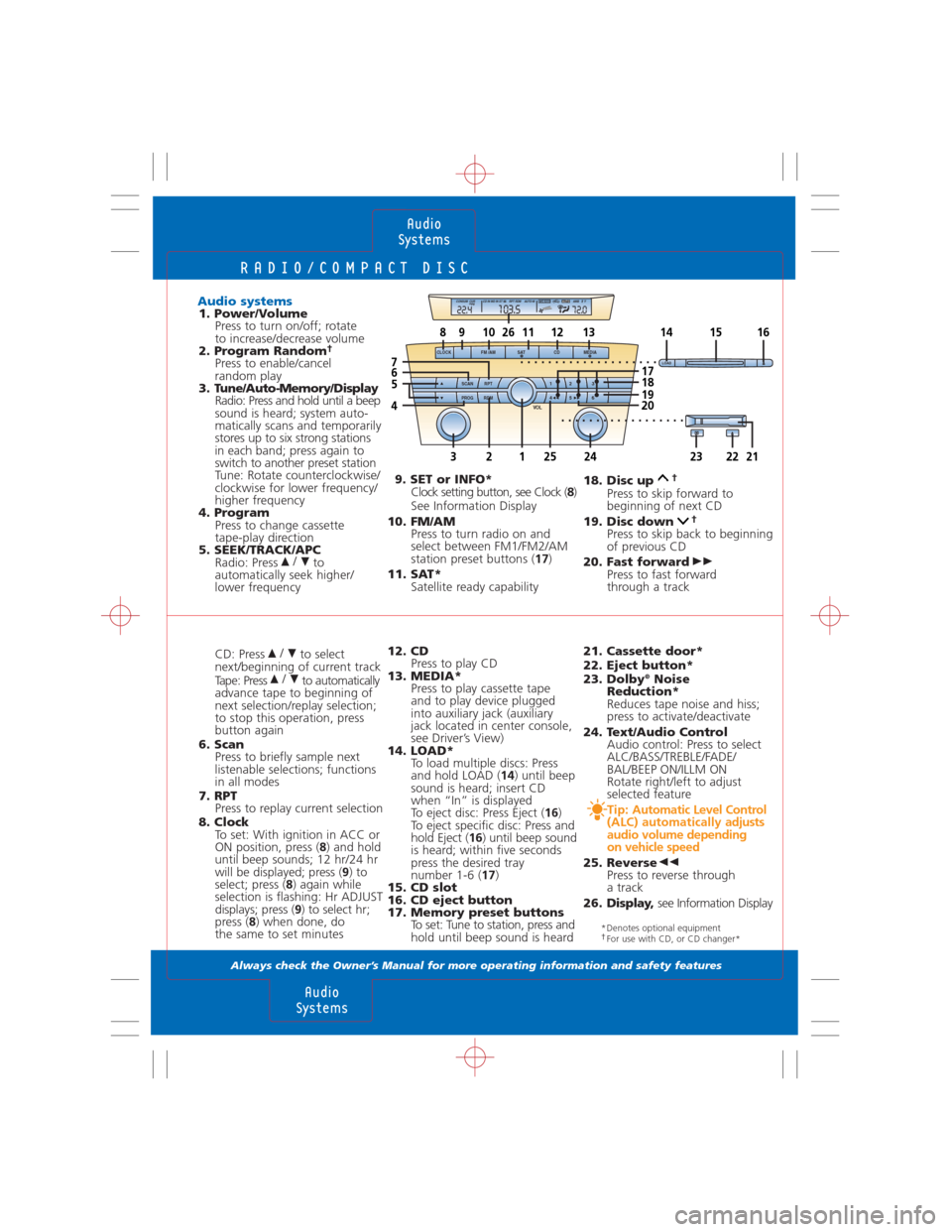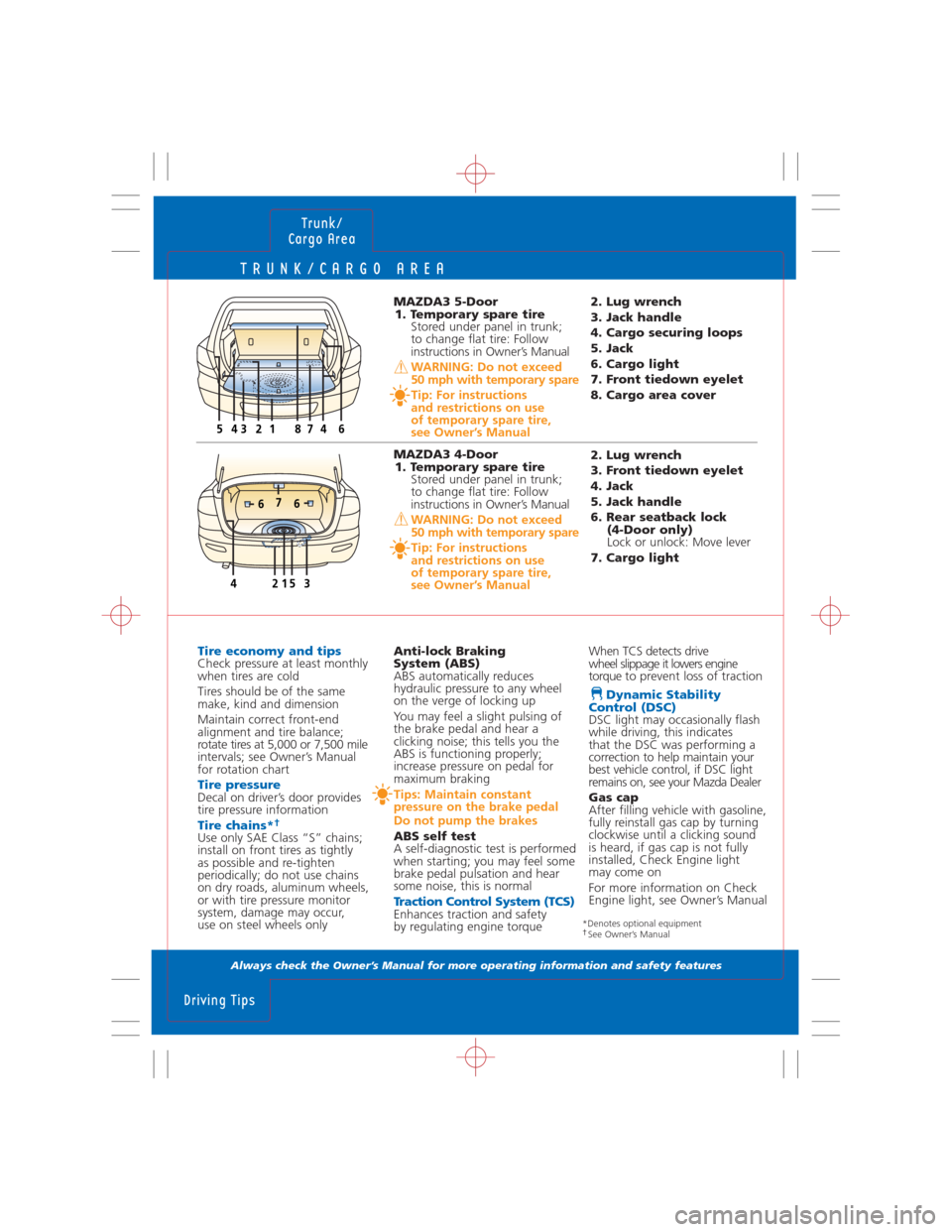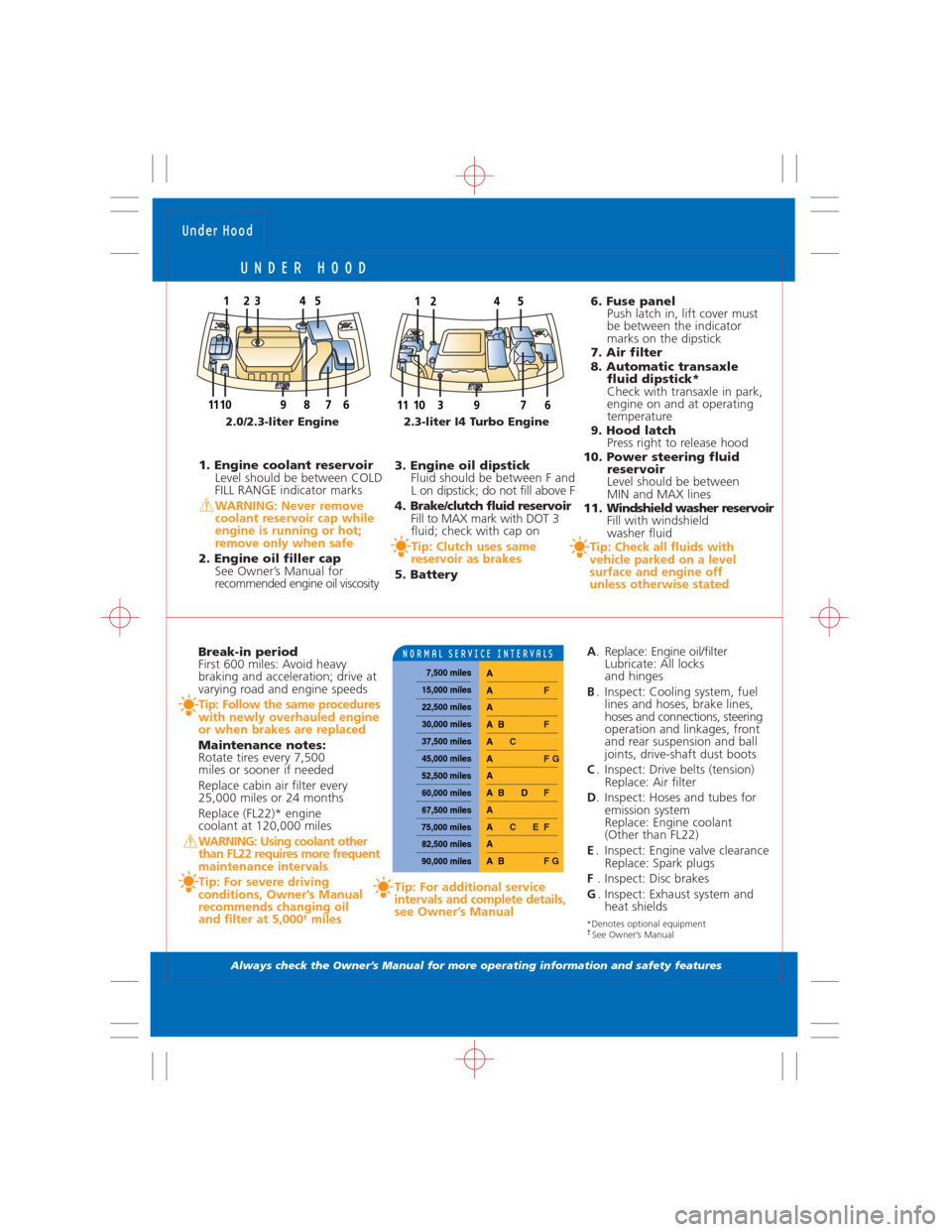MAZDA MODEL 3 HATCHBACK 2007 Quick Tips (in English)
Manufacturer: MAZDA, Model Year: 2007, Model line: MODEL 3 HATCHBACK, Model: MAZDA MODEL 3 HATCHBACK 2007Pages: 14, PDF Size: 2.24 MB
Page 11 of 14

CLIMATE CONTROLS
Always check the Owner’s Manual for more operating information and safety features
1. Air flow selections
= air to dash
= air to dash and floor
= air to floor
= air to floor and windshield
= defrost, air to windshield
2. Fan control
Rotate knob right/left to
increase/decrease fan speed6. Air Conditioning*
Press to activate/deactivate
Tip: With air flow switch in
floor position and
defrost positions or :
A/C turns ON, air intake
switches to fresh air
7. OFF
Press (7) to turn system off
(Automatic System), rotate
knob (2) to 0 (Manual System) Automatic operation
Press AUTO (9) for automatic
operation; rotate dial to set
temperature, see Owner’s Manual
Tip: Automatic climate control
display viewed via information
display, see below
3. Temperature control
Rotate knob to blue for cool,
red for warm
4. Rear window defogger
Press to activate/deactivate
5. Air intake control
Press to select recirculated
(indicator light on) or outside
(indicator light off) air mode
WARNING: Do not use
recirculated air mode in cold
weather; windows will fog
and hamper vision
8. AMB*
Press to display ambient
temperature, press again to
switch display to temperature
set for air conditioner
Tip: With audio system
ON, temperature display
can be switched between
Centigrade and Fahrenheit
or vice versa by pressing
audio POWER button and
MEDIA button and holding
both for five seconds or more
Control positions for
maximum defrost
Fan to maximum, temperature
to maximum hot, air flow
selector knob to
Tips: To help prevent windshield
fogging in humid weather,
select before starting engine
To prevent moisture buildup,
never drive with A/C system off
Objects placed under the front
seats may interfere with air
flow to the rear
Information displayInformation display has the
following functions: Trip computer*/
clock (1), audio display, automatic
climate control display and ambient
temperature display* (AMB)
Trip computer* can display current
fuel economy, average fuel economy,
approximate distance you cantravel on available fuel and average
vehicle speed
Ignition must be in ON position,
press INFO button* (2) to change
trip computer display mode
Tip: Press CLOCK button (3)
to display clock
See Owner’s Manual
Climate
Controls
Information
Display
PUSH OFF PUSH AUTO MODE
AMB A/C
2 7 9 1
MODE
04132
A/C
564
1233
6 5 4 8 Manual Automatic*
CLOCK INFO FM /AM SAT CD MEDIA
23
AMB CD IN MD IN ST CONSUM CUR
mpgRPT RDM AUTO-M FO72.0103.522.4AUTOA/C ECO1
*Denotes optional equipment
Page 12 of 14

RADIO/COMPACT DISC
Always check the Owner’s Manual for more operating information and safety features
CD: Press to select
next/beginning of current track
Tape: Press to automatically
advance tape to beginning of
next selection/replay selection;
to stop this operation, press
button again
6. Scan
Press to briefly sample next
listenable selections; functions
in all modes
7. RPT
Press to replay current selection
8. Clock
To set: With ignition in ACC or
ON position, press (8) and hold
until beep sounds; 12 hr/24 hr
will be displayed; press (9)to
select; press (8) again while
selection is flashing: Hr ADJUST
displays; press (9) to select hr;
press (8) when done, do
the same to set minutes
/
/
Audio systems1. Power/Volume
Press to turn on/off; rotate
to increase/decrease volume
2. Program Random
†Press to enable/cancel
random play
3. Tune/Auto-Memory/Display
Radio: Press and hold until a beep
sound is heard; system auto-
matically scans and temporarily
stores up to six strong stations
in each band; press again to
switch to another preset station
Tune: Rotate counterclockwise/
clockwise for lower frequency/
higher frequency
4. Program
Press to change cassette
tape-play direction
5. SEEK/TRACK/APC
Radio: Press to
automatically seek higher/
lower frequency
/
12. CD
Press to play CD
13. MEDIA*
Press to play cassette tape
and to play device plugged
into auxiliary jack (auxiliary
jack located in center console,
see Driver’s View)
14. LOAD*
To load multiple discs: Press
and hold LOAD (14) until beep
sound is heard; insert CD
when “In” is displayed
To eject disc: Press Eject (16)
To eject specific disc: Press and
hold Eject (16) until beep sound
is heard; within five seconds
press the desired tray
number 1-6 (17)
15. CD slot
16. CD eject button
17. Memory preset buttons
To set: Tune to station, press and
hold until beep sound is heard 9. SET or INFO*
Clock setting button, see Clock (8)
See Information Display
10. FM/AM
Press to turn radio on and
select between FM1/FM2/AM
station preset buttons (17)
11. SAT*
Satellite ready capability
21. Cassette door*
22. Eject button*
23. Dolby
®Noise
Reduction*
Reduces tape noise and hiss;
press to activate/deactivate
24. Text/Audio Control
Audio control: Press to select
ALC/BASS/TREBLE/FADE/
BAL/BEEP ON/ILLM ON
Rotate right/left to adjust
selected feature
Tip: Automatic Level Control
(ALC) automatically adjusts
audio volume depending
on vehicle speed
25. Reverse
Press to reverse through
a track
26. Display, see Information Display
18. Disc up†
Press to skip forward to
beginning of next CD
19. Disc down
†Press to skip back to beginning
of previous CD
20. Fast forward
Press to fast forward
through a track
Audio
Systems
Audio
Systems
*Denotes optional equipment†For use with CD, or CD changer*
LOADCLOCK
SCAN
PROGRPT
RDM
1
42
53
6
VOL
FM /AM SAT CD MEDIA
3242322211225
8910111214151613
65
7
4
181920
17 . . . . . . . . . . . . . . . . . . . .
. . . . . . . . . . . . . . . . . .
AMB CD IN MD IN ST CONSUM CUR
mpgRPT RDM AUTO-M FO72.0103.522.4AU TOA/C ECO
26
Page 13 of 14

TRUNK/CARGO AREA
Always check the Owner’s Manual for more operating information and safety features
Trunk/
Cargo Area
Driving Tips
When TCS detects drive
wheel slippage it lowers engine
torque to prevent loss of traction
Dynamic Stability
Control (DSC)
DSC light may occasionally flash
while driving, this indicates
that the DSC was performing a
correction to help maintain your
best vehicle control, if DSC light
remains on, see your Mazda Dealer
Gas cap
After filling vehicle with gasoline,
fully reinstall gas cap by turning
clockwise until a clicking sound
is heard, if gas cap is not fully
installed, Check Engine light
may come on
For more information on Check
Engine light, see Owner’s Manual
MAZDA3 5-Door
1. Temporary spare tire
Stored under panel in trunk;
to change flat tire: Follow
instructions in Owner’s Manual
WARNING: Do not exceed
50 mph with temporary spare
Tip: For instructions
and restrictions on use
of temporary spare tire,
see Owner’s Manual
Tire economy and tips
Check pressure at least monthly
when tires are cold
Tires should be of the same
make, kind and dimension
Maintain correct front-end
alignment and tire balance;
rotate tires at 5,000 or 7,500 mile
intervals; see Owner’s Manual
for rotation chart
Tire pressure Decal on driver’s door provides
tire pressure information
Tire chains*†
Use only SAE Class “S” chains;
install on front tires as tightly
as possible and re-tighten
periodically; do not use chains
on dry roads, aluminum wheels,
or with tire pressure monitor
system, damage may occur,
use on steel wheels onlyAnti-lock Braking
System (ABS)
ABS automatically reduces
hydraulic pressure to any wheel
on the verge of locking up
You may feel a slight pulsing of
the brake pedal and hear a
clicking noise; this tells you the
ABS is functioning properly;
increase pressure on pedal for
maximum braking
Tips: Maintain constant
pressure on the brake pedal
Do not pump the brakes
ABS self test
A self-diagnostic test is performed
when starting; you may feel some
brake pedal pulsation and hear
some noise, this is normal
Traction Control System (TCS)Enhances traction and safety
by regulating engine torque 2. Lug wrench
3. Jack handle
4. Cargo securing loops
5. Jack
6. Cargo light
7. Front tiedown eyelet
8. Cargo area cover
MAZDA3 4-Door
1. Temporary spare tire
Stored under panel in trunk;
to change flat tire: Follow
instructions in Owner’s Manual
WARNING: Do not exceed
50 mph with temporary spare
Tip: For instructions
and restrictions on use
of temporary spare tire,
see Owner’s Manual
2. Lug wrench
3. Front tiedown eyelet
4. Jack
5. Jack handle
6. Rear seatback lock
(4-Door only)
Lock or unlock: Move lever
7. Cargo light
164432587
2
7
415
6
6
3
*Denotes optional equipment†See Owner’s Manual
Page 14 of 14

UNDER HOOD
Always check the Owner’s Manual for more operating information and safety features
Under Hood
1. Engine coolant reservoir
Level should be between COLD
FILL RANGE indicator marks
WARNING: Never remove
coolant reservoir cap while
engine is running or hot;
remove only when safe
2. Engine oil filler cap
See Owner’s Manual for
recommended engine oil viscosity
Break-in period
First 600 miles: Avoid heavy
braking and acceleration; drive at
varying road and engine speeds
Tip: Follow the same procedures
with newly overhauled engine
or when brakes are replaced
Maintenance notes:
Rotate tires every 7,500
miles or sooner if needed
Replace cabin air filter every
25,000 miles or 24 months
Replace (FL22)* engine
coolant at 120,000 miles
WARNING: Using coolant other
than FL22 requires more frequent
maintenance intervals
Tip: For severe driving
conditions, Owner’s Manual
recommends changing oil
and filter at 5,000
†milesTip: For additional service
intervals and complete details,
see Owner’s Manual
3. Engine oil dipstick
Fluid should be between F and
L on dipstick; do not fill above F
4. Brake/clutch fluid reservoir
Fill to MAX mark with DOT 3
fluid; check with cap on
Tip: Clutch uses same
reservoir as brakes
5. Battery
A. Replace: Engine oil/filter
Lubricate: All locks
and hinges
B. Inspect: Cooling system, fuel
lines and hoses, brake lines,
hoses and connections, steering
operation and linkages, front
and rear suspension and ball
joints, drive-shaft dust boots
C. Inspect: Drive belts (tension)
Replace: Air filter
D. Inspect: Hoses and tubes for
emission system
Replace: Engine coolant
(Other than FL22)
E. Inspect: Engine valve clearance
Replace: Spark plugs
F. Inspect: Disc brakes
G. Inspect: Exhaust system and
heat shields 6. Fuse panel
Push latch in, lift cover must
be between the indicator
marks on the dipstick
7. Air filter
8. Automatic transaxle
fluid dipstick*
Check with transaxle in park,
engine on and at operating
temperature
9. Hood latch
Press right to release hood
10. Power steering fluid
reservoir
Level should be between
MIN and MAX lines
11. Windshield washer reservoir
Fill with windshield
washer fluid
Tip: Check all fluids with
vehicle parked on a level
surface and engine off
unless otherwise stated
9111067
2451
91110786
15423
3
2.0/2.3-liter Engine 2.3-liter I4 Turbo Engine
*Denotes optional equipment†See Owner’s Manual
NORMAL SERVICE INTERVALS
7,500 miles
15,000 miles
22,500 miles
30,000 miles
37,500 miles
45,000 miles
52,500 miles
60,000 miles
67,500 miles
75,000 miles
82,500 miles
90,000 miles
A BF G A A
C E F A A
B D F A A
F G A C A
BF A A F A